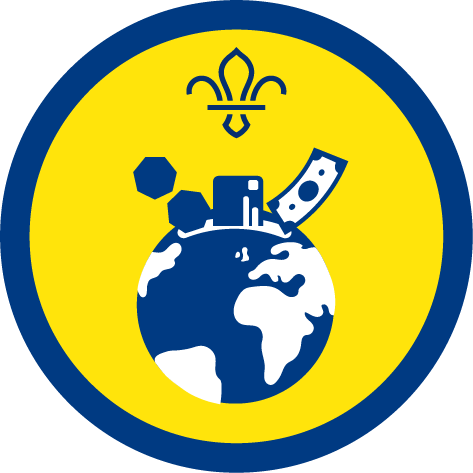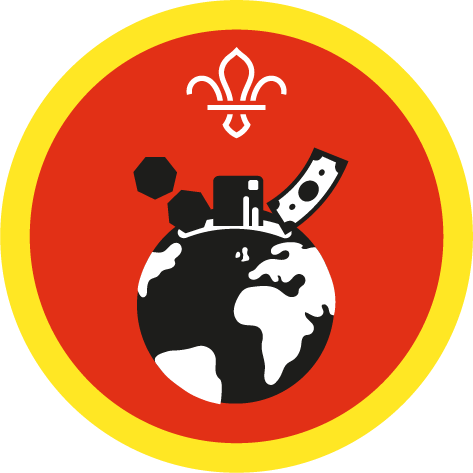
Create a recycled robot
You’ll need
- Clean items of recycling
- Craft materials (for example, tissue paper, pipe cleaners, stickers)
- Glue sticks
- Sticky tape
- Coloured pens or pencils
- Big pieces of card
- Something to use as tokens
Before you begin
- Use the safety checklist to help you plan and risk assess your activity. Additional help to carry out your risk assessment, including examples can be found here. Don’t forget to make sure all young people and adults involved in the activity know how to take part safely.
- Make sure you’ll have enough adult helpers. You may need some parents and carers to help if you’re short on helpers.
This activity gets young people saving up recycled items to build a robot together. They earn tokens by playing games and then exchange those tokens for materials to build their robot - they will have to decide what to spend their tokens on - and then vote for the best robot!
Planning this activity
- Ask everyone to bring in some clean items of recycling. Household items, such as milk bottles, tin foil, toilet roll tubes and cereal boxes all work really well. If you’ve got space, you could build a collection over a few weeks.
- Assign token values to different materials and put them somewhere everyone can see them. Materials you’ve got plenty of should be worth fewer tokens and if you only have a small amount of a material, make it worth more tokens. It’s up to you how you display the values – you could make little signs or write on the materials.
- You might want to run the Pack your Bags activity with your group first to get a taste of budgeting and identifying needs and wants.
- This activity could be run over multiple sessions, depending on how long you want to collect recycled items for.
Step 1: What makes the best robot?
- The person leading the activity should put all of the materials on display and tell everyone that no one ‘owns’ these items, even if they brought them in. They should explain that each item is worth a certain number of tokens and that all of the items are up for grabs.
- Everyone should work together to decide what makes the best robot. Maybe it’s the tallest, the shiniest or the one with the most functions? Everyone should choose something achievable that they could try to make with the materials available. If people find it tricky to decide, they could vote on the most popular ideas.
- Everyone should split into small teams. Each team should move into their own space.
Step 2: Points make parts
- Everyone should play a quick game as or in teams, such as Game of Aim, Noughts and crosses relay or Human knot.
- The person leading the activity should give everyone one token for taking part. They should give the winning team three extra tokens, the team that came second two extra tokens, and the team that came third one extra token.
- Each group should decide whether they want to spend any of their tokens. Explain that it’s up to them. If they wait too long then the cheaper materials may disappear, but if they don’t save the tokens up then they may never be able to afford the more expensive materials.
- At the end of each game, someone in each team should write down how many tokens their team has combined and how many they have spent on materials so far. Make sure everyone understands that they’re spending their tokens as a team so they need to come to a joint decision.
- Everyone should play another quick game and the person leading the activity should award tokens, remind people how many tokens they have and give people the chance to spend them.
- Everyone should repeat step four until they’ve played enough games. After the final game, everyone should spend the rest of their tokens.
Step 3: Construct your robot
- Each team should sit around their piece of card. The person leading the activity should lay their materials out.
- Teams should work together to build their robot by sticking their materials to the piece of card. They should remember the group’s decision about what makes the best robot as they build.
- Once everyone’s finished, they should take it in turns to show off their robot to the rest of the group. Does a robot stand out as the best?
- Decide whether there’ll be or how you’ll choose a winner. Volunteers, young people, parents and carers, or young leaders could anonymously vote on their favourite. You could also give out prizes for best teamwork, best communication, most helpful and best invention.
Reflection
The person leading the activity should congratulate everyone on working together to decide when to save and when to spend their tokens. Did anyone want to spend all of the tokens as soon as they had them? How did it feel to wait and save tokens for better materials? How did it feel when people spent tokens that they’d been carefully saving?
The person leading the activity should explain that people do the same with real money. When people keep their money safe, it collects over time so people can put it towards something that’s more expensive – just like the tokens and the materials. Did anyone find a really good approach to saving their tokens? Maybe some people found a balance where they used some tokens as soon as they got them and saved some towards some of the more exciting materials. Did anyone have a good technique for making decisions? Maybe people kept a list of the tokens they had or asked an adult to separate them into different piles.
Safety
All activities must be safely managed. You must complete a thorough risk assessment and take appropriate steps to reduce risk. Use the safety checklist to help you plan and risk assess your activity. Always get approval for the activity, and have suitable supervision and an InTouch process.
- Glue and solvents
Always supervise young people appropriately when they’re using glue and solvent products. Make sure there’s plenty of ventilation. Be aware of any medical conditions that could be affected by glue or solvent use and make adjustments as needed.
- Rubbish and recycling
All items should be clean and suitable for this activity.
- Active games
The game area should be free of hazards. Explain the rules of the game clearly and have a clear way to communicate that the game must stop when needed. Take a look at our guidance on running active games safely.
Feel free to adjust the number of tokens the winners get in each game to make it work for you.
You could ask the group to set the values of materials. They’ll have to work out how many tokens each should cost depending on how common the item is and how many tokens are up for grabs.
Introduce the idea of swapping materials. How much are they worth now? What could they be traded for? People may be surprised by the way that items can lose or gain value.
You could award bonus tokens in the games for people who show that they’re a helpful team member, a good sport or a good friend.
It doesn’t matter if some people don’t bring in any items as everything’s combined for people to choose from.
It’s up to you whether people build their robots on the floor or on a table. You can choose whatever’s more accessible for everyone.
Make sure everyone can join in with all of the games.
All Scout activities should be inclusive and accessible.
Asking young people to think about planning a small event for the community. People who plan events usually have to manage a budget and make tough decisions. For example, what would people need to think about before buying a selection of fruit and snacks for an activity day or camp?
Take a look at more money skills activities.
It’s up to the young people to decide what makes the best robot – make sure everyone’s voice is heard as they decide. Make sure teams have the freedom to make their own decisions – if a team wants to spend all of their tokens every round or save them all until the end, it’s up to them.

